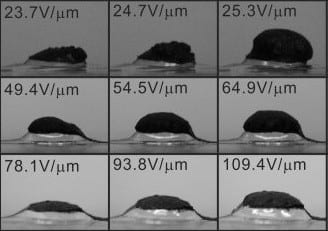 Dielectric elastomers can provide efficient electrical to mechanical energy conversion, and are finding use as actuators in ‘artificial muscles’ for applications such as robotics, vibration control, and haptic technology. Now, a newly synthesized series of dielectric elastomers that show impressive actuation strain, high energy density, and fast response, all without pre-stretching the polymer, have been reported by Xiaofan Niu, Qibing Pei and colleagues in the Journal of Polymer Science: Polymer Physics.
Dielectric elastomers can provide efficient electrical to mechanical energy conversion, and are finding use as actuators in ‘artificial muscles’ for applications such as robotics, vibration control, and haptic technology. Now, a newly synthesized series of dielectric elastomers that show impressive actuation strain, high energy density, and fast response, all without pre-stretching the polymer, have been reported by Xiaofan Niu, Qibing Pei and colleagues in the Journal of Polymer Science: Polymer Physics.
“Dielectric elastomers have emerged as an important smart material for muscle-like, large strain actuation,” says lead author Niu. For these applications, the material needs low stiffness, a high dielectric constant, and a high electrical breakdown strength to survive the multiple voltage cycles.
Currently, the selection of possible dielectric elastomers for these applications is rather limited, with two commercially available polymers used most widely; much research focuses on improving the properties of existing polymers to improve performance. In order to obtain actuation strains greater than 33% with these polymers, mechanical pre-stretching is often used. This process also reduces the thickness of the film so it requires a lower actuation voltage. Unfortunately, pre-stretching complicates the fabrication process and reduces the lifetime of the actuator.
Niu and his colleagues use UV radiation polymerization to synthesize a new type of dielectric elastomer that doesn’t need pre-stretching to achieve good performance. The fabrication process would be easy to implement on a production line, as well as to make stacks of elastomer layers, so it’s ideal for future applications. The researchers were able to control the material’s mechanical and electromechanical properties by customizing the crosslink density and adding a plasticizer.
The key to tuning the polymers’ properties is in the formulation of the prepolymers prior to polymerization. Niu and colleagues blend together oligomers, which act as the framework to provide the basic mechanical properties of the system, with reactive diluents, photoinitiators and other additives. The reactive diluents are molecules such as acrylates, which can be used to adjust the rheology, provide crosslinking and precisely tune mechanical properties. The other additives can be added to the precursors to meet other special requirements.
“We used the polymer elasticity principle and synthesized a new dielectric elastomer with designed electromechanical behavior,” says Niu, who did the polymer synthesis. “This work is a step towards dielectric elastomers that can be designed and tuned based on the performance specification.” Indeed, the impressive electromechanical strain of 314% with maximum breakdown field of 236 V/μm and suppression of electromechanical instabilities bodes well for future use of the elastomers.
In the future, Pei and Niu say they will try to improve processability and overall actuator performance, as well as fabricating multilayer stack actuators with high force and power output. “We will also apply the design principle to other material systems such as silicone and polyurethane elastomers,” says Niu.

















